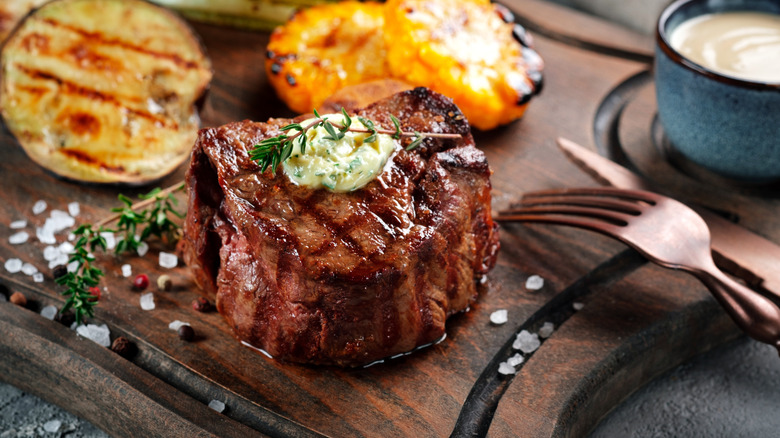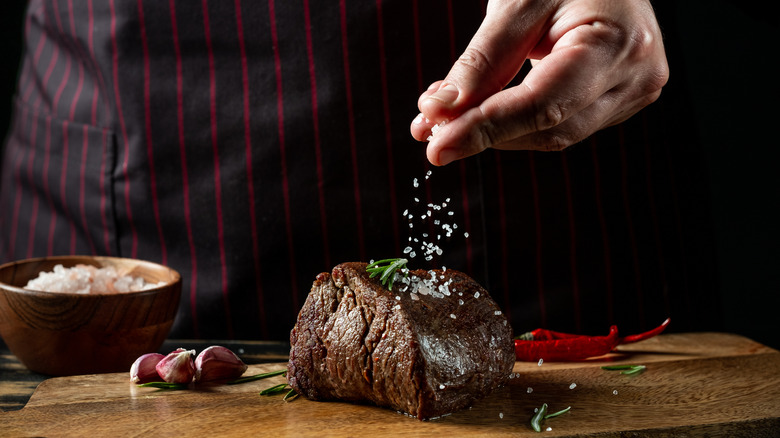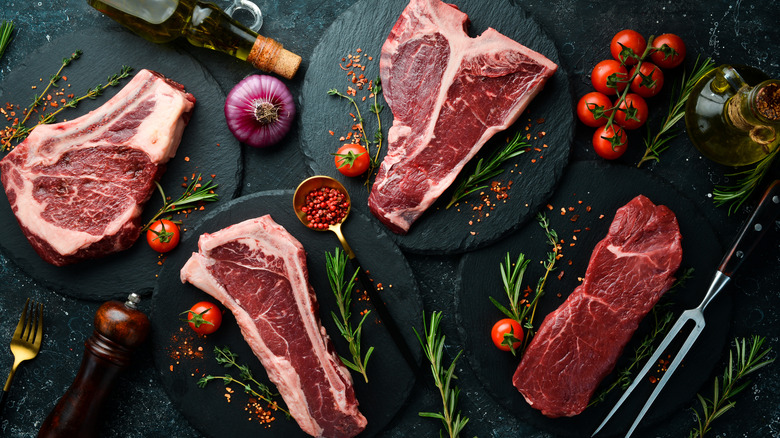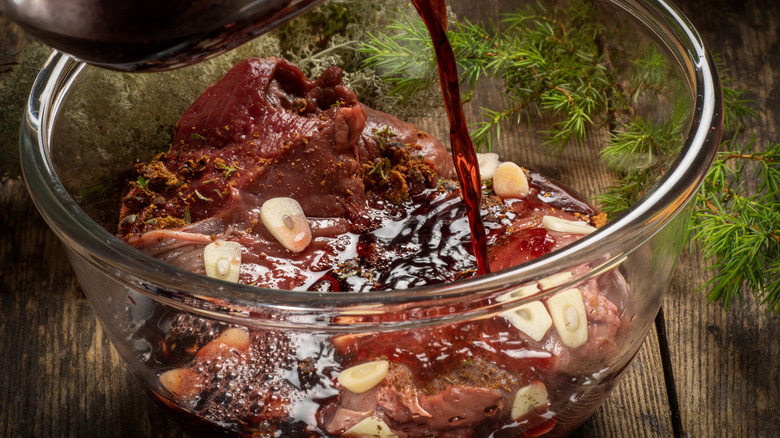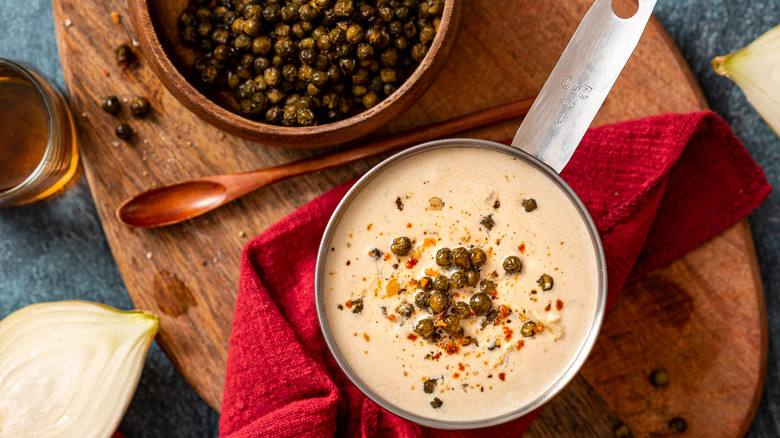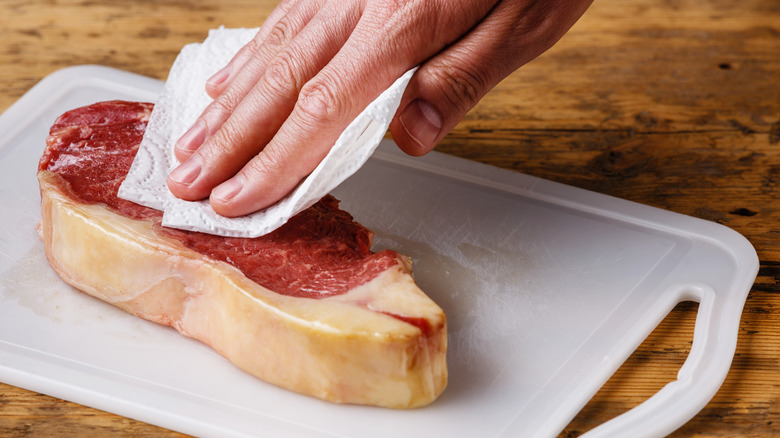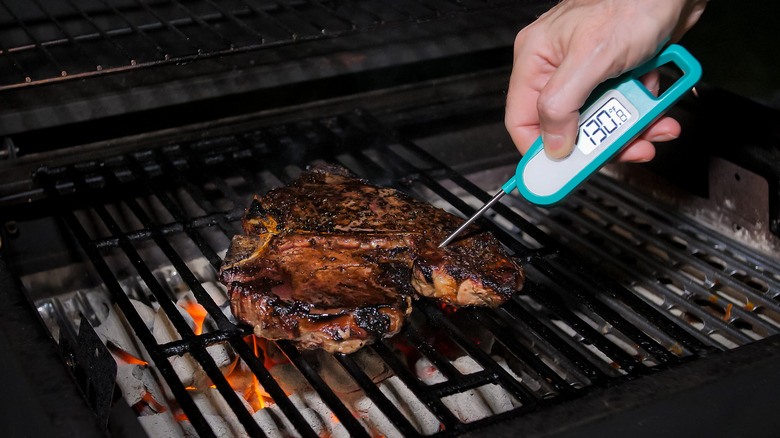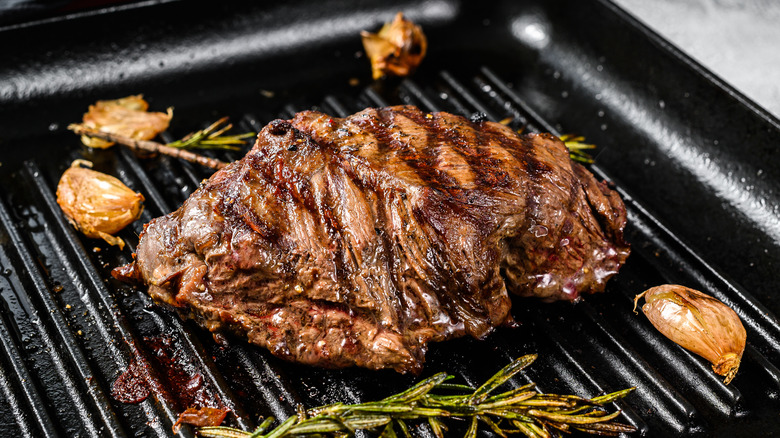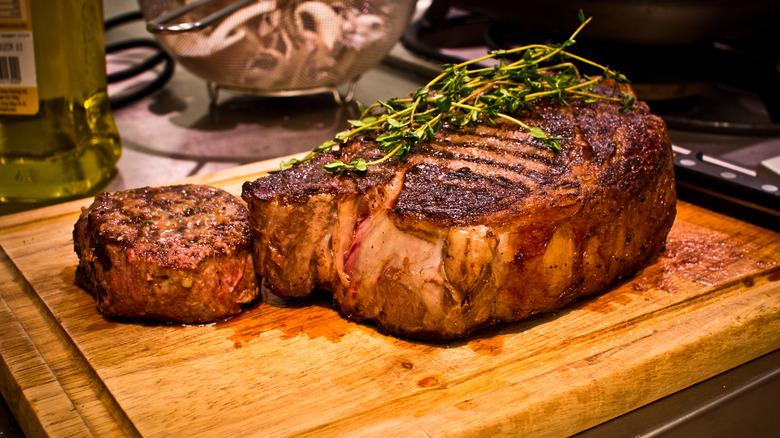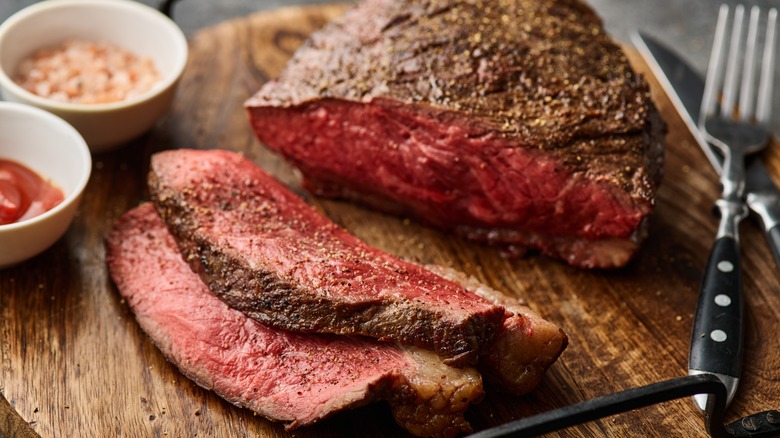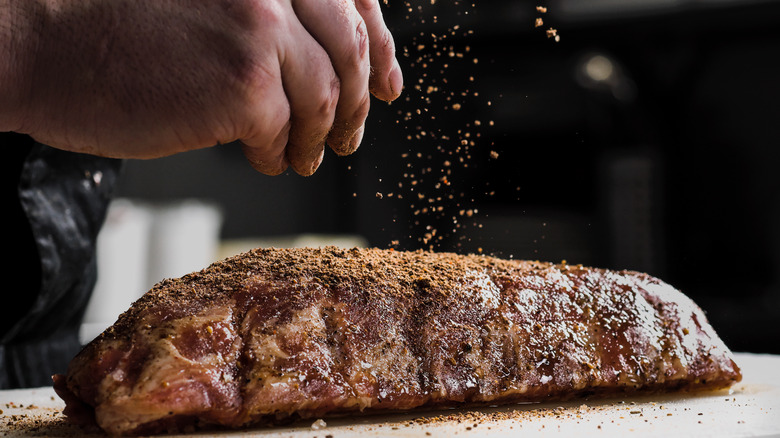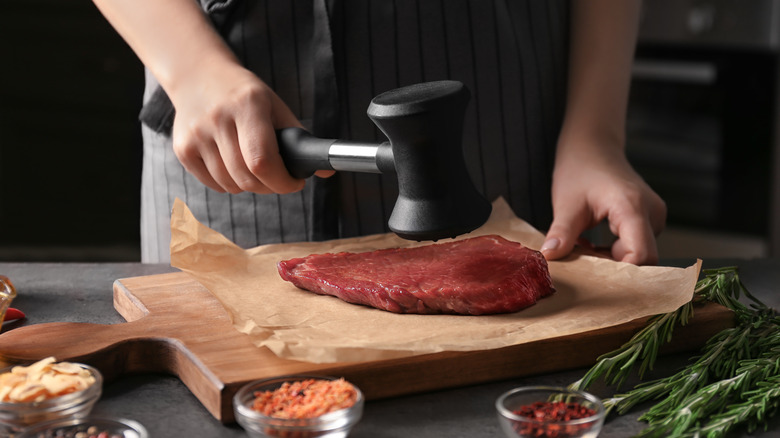13 Tips You Need When Seasoning A Steak
Grilled steak is fabulous on its own. But, seasoning is the secret to a succulent and tasty steak. When it comes to seasoning a steak, one can stick with the traditional method of adding a few sparkles of coarse salt and pepper, along with a drizzle of garlic-infused butter and call it a day. Taking some time to learn a few other nuances of the cooking process can transform your steak from ordinary to spectacular, regardless of your level of cooking expertise. Seasoning a steak is a necessary step in the cooking process and can significantly enhance the overall taste and quality of the meal. It helps to bring out the meat's natural flavors, create a nice crust, make the meat more tender, and also provide an opportunity to be creative with the flavors. The combination of the juicy texture of the meat and the savory flavors of the seasoning and marinade makes for a delicious and satisfying meal.
Use plenty of salt and pepper
One of the fundamental and simplest steps in seasoning your steak is using a generous amount of coarse salt and pepper. This basic seasoning combination can enhance the meat's natural flavors and bring out its full potential. But, not all salt and pepper are created equal (don't use table salt on your steak), and using the right amount can make a big difference in the final outcome of your dish. Coarse salt enhances the meat's natural flavors and brings out its richness, while pepper adds a subtle heat and a slight crunch. The coarse texture of the salt and pepper also helps to create a nice crust on the surface of the steak, which helps to lock in moisture and flavors.
Using a generous amount of salt and pepper also helps to create a balance of flavors: a nice balance of salty and savory, with a subtle kick of heat from the pepper. A light sprinkle will not give the steak the flavor and texture it needs to be delicious. Use a clean paper towel to dry the steak completely before seasoning. Once your steak is dry, season both sides of the steak with plenty of coarse salt and pepper. Be sure to press the seasonings onto the steak to help them stick together.
Use the proper cut of steak
When cooking a perfect steak, the cut of meat you choose is just as significant as the seasoning you use. A ribeye, T-bone, or New York strip steak all have their own unique qualities that make them perfect for different occasions and cooking methods.
The ribeye steak is an alternative from the cow's rib section and is known for its rich flavor and marbling. This cut is best cooked on a grill or in a cast-iron skillet and is perfect for those who like their steak cooked medium-rare to medium. The marbling in the ribeye makes it a juicy cut that is ideal for rich, bold flavors. The T-bone cut has a strip side and a filet side, which makes it an excellent option for those who want a mix of flavors and textures in their steak. The New York strip steak is ideal for grilling as a leaner option than the ribeye or T-bone and perfect for those who prefer a more delicate flavor.
Try marinating steak in a flavorful liquid
Marinating is a process of soaking meat, fish, or poultry in a liquid mixture before cooking to infuse the meat with flavor, as well as make it more tender. The best marinade ratio typically includes an acidic ingredient, such as lemon juice or vinegar, as well as herbs, spices, and oils. Selecting a high-quality cut of meat is crucial when marinating steak. A good steak should be marbled with fat, which will add flavor and help to keep the meat moist during cooking. Ribeye, sirloin, and flank steak are a few of the cuts of steak to marinate.
When it comes to choosing a marinade, the options are endless. You can either buy one from a shop or prepare a steak marinade at home. Some popular marinade ingredients include olive oil, soy sauce, garlic, and herbs like rosemary and thyme. Keep in mind, if the steak is marinated for more than 24 hours, the meat will start to degrade due to the acid in the marinade.
Remove excess marinade before cooking steak, then use paper towels to pat it dry. This will help to ensure that the steak gets a good sear and develops a nice crust.
Be mindful of the steak temperature before cooking
One common mistake most home cooks make is trying to cook the steak straight out of the fridge. When cooking a cold steak, the fibers in the meat contract and cause the steak to become more rigid. The fibers relax and become more pliable when the steak reaches room temperature. Thus, at room temperature, the steak will cook more evenly and be more tender.
The USDA says that a steak should not be kept at room temperature for more than two hours. This is because it helps bacteria grow and makes the steak unsafe to eat. Take your steak out of the refrigerator 30 to 60 minutes before you cook it to get it to room temperature. One popular defrosting method is to dunk the steak for two to three hours in a bowl of cold water after putting it in a sealable plastic bag.
Try out different sauces and toppings
By experimenting with various sauces and toppings, you can enhance a steak's flavor in several ways. Some popular steak sauces include chimichurri, hollandaise, and béarnaise sauce. These sauces are typically made with herbs, garlic, and lemon juice, which can add a lot of flavor to the steak.
Another great way to add flavor to a steak is by topping it with something creamy, such as blue cheese or gorgonzola. These cheeses can add a nice tang to the steak and complement the rich flavor of the meat. Other popular toppings include sautéed mushrooms, caramelized onions, or fried eggs. These toppings can add a nice texture and complement the flavor of the steak to make it even more satisfying.
Remember that less is often more. Don't go overboard, as it can inadvertently ruin the steak's flavors. IIt's important to choose sauces and toppings that bring out the flavors of the steak instead of covering them up.
Pat steak dry for a better sear
When you're ready to cook your steak — and once it has reached room temperature — it's time to pat the steak dry with paper towels. A dry surface on the steak allows for a better sear. When a steak is wet, the moisture on the surface of the steak will steam instead of sear. Additionally, the steam generated by the moisture can cause the steak to lose its natural juices, resulting in a dryer, less flavorful steak.
A dry steak will also allow the heat to create a nice crust on the surface to lock in the moisture and natural flavor of the steak. It also allows the seasonings to adhere to the steak better, resulting in a more flavorful final product.
Patting your steak dry is a quick and easy process. Take a few paper towels and gently press them against the surface of the steak, making sure to remove as much moisture as possible. Be sure to use a clean paper towel for each side of the steak.
Use an instant-read thermometer
Cooking a steak to perfection requires more than just the proper seasoning. One often overlooked step is checking the steak's internal temperature with a meat thermometer. This simple step can make a huge difference in the end result of your steak. The internal temperature of a steak is the most accurate way to determine when it's cooked to your desired level of doneness. Cooking a steak to the correct temperature ensures that it's safe to eat and cooked to your liking. Undercooked steak can be tough and unappetizing, while overcooked steak can be dry and tough.
You can use a few different types of thermometers to check a steak's internal temperature. The most common are instant-read thermometers, which can give a temperature reading in seconds. Another option is a leave-in thermometer, which stays in the steak throughout the cooking process. Make sure to monitor the steak to know when it reaches the recommended internal temperature of doneness.
Use a cast iron skillet for the best sear
While there are many methods to cook a steak, using a cast-iron skillet or grill is one of the best ways to get that perfect crust and create a flavorful char. One of the advantages of cooking in a cast iron skillet is that it can retain heat very well. This means that the skillet will stay hot even after you've added the steak to it, which will help to ensure that the steak cooks evenly. Grilling is also an excellent option for searing a steak. It provides nice char and actual grill marks, which makes it perfect for outdoor cooking, and creates a smokiness that goes well with steak
Here's a tip for cooking a steak in a cast iron skillet without all the oily mess. Sear the steak on high heat for two minutes per side, lower the flame to medium heat, and flip the meat every two minutes till you are satisfied with the meat's doneness. This method ensures the steak has a nice crust on the outside while the inside is rare or medium-rare. High heat will quickly caramelize the surface of the steak and help create the ultimate steak crust.
Use the reverse-sear method
The reverse-sear method involves first cooking the steak at a low temperature until it is nearly done, and then searing it over high heat. This results in a steak that is cooked more thoroughly and has a crisp crust on the outside. The reverse sear method is a more controlled way of cooking steaks, which means you can achieve consistent results every time.
By cooking the steak at a low temperature first, the inside of the steak has time to cook evenly from edge to edge without the outside of the steak becoming overcooked. The reverse sear method also allows for a better crust outside of the steak because it is seared on high heat after it's cooked through. One of the best ways to cook a steak is by placing the steak on a baking sheet and cooking it in an oven that is preheated up to 275 degrees. Once the steaks have achieved your desired doneness, remove them from the oven and cook them in a hot skillet until the steak develops a nice crust outside.
Allow the steak to rest before slicing
Allowing the steak to rest may seem like a minor step, but it can significantly impact the meat's overall taste and texture. When you cut into the steak immediately after cooking it, the internal steak juices will leak out and onto the cutting board. Letting the meat rest before slicing helps retain the juices, resulting in a more flavorful and juicy steak.
Figuring out how long to let your steak rest depends on its thickness and cut: a thicker steak will require more resting time than a thinner cut. Generally speaking, for every inch of thickness, the steak should rest for around five minutes. For example, if you have a three-inch thick steak, you should allow it to rest for about 15 minutes. It is recommended to use a meat thermometer to check the steak's internal temperature and to rest the steak for a while, regardless of the temperature, to ensure that the juices inside have time to redistribute.
Try different dry-rub blends
While using a generous amount of coarse salt and pepper is a great starting point, trying different steak rub blends can take your dish to the next level. Various spices and herbs can enhance the meat's natural flavors and add complexity to the overall taste. For example, a dry rub made with cumin, paprika, and garlic powder can give your steak a smoky and earthy flavor. A rub made with thyme, rosemary, and lemon zest can add a fresh and herby taste.
Another reason to try different seasoning blends is to change the taste of your steak without changing the cut of meat. For example, if you're tired of the usual T-bone steak and want to change things up, include garlic powder, onion powder, paprika, or cumin. You could also add coffee to a steak rub. Additionally, by combining your preferred spices and keeping them in an airtight container, you can create your own seasoning blend.
By combining your preferred spices and keeping them in an airtight container, you can create your own seasoning blend that you can use every day at home. You can also turn to one of the many store-bought steak rubs that can add more complex flavors to your meat. When seasoning steak, be sure to season both sides generously and press the seasonings onto the steak to help them adhere.
Experiment with different cooking methods
Different cooking methods can enhance the meat's natural flavors and add complexity to the overall taste. Some popular methods include grilling, pan-frying, broiling, sous-vide, and reverse-searing.
For example, sous-vide cooking can produce a steak that is incredibly tender and evenly cooked, while broiling will give you a steak with a nice crust and a smoky flavor. With cooking sous-vide, the system reaches a precise temperature, which means the steak can be cooked to the exact level of doneness that you desire. This is especially helpful for those who are not experienced in cooking steaks, as it eliminates the guesswork.
Broiling a steak is another way to cook a delicious and juicy steak with minimal effort. A broiler should be preheated to high heat for several minutes before adding the steak. This will ensure that the broiler is hot enough to create a nice crust on the outside of the steak. It's also important to place the steak on the top rack of the oven so that it is close to the heat source.
Use a meat tenderizer tool to break down tough fibers
A meat tenderizing tool helps break down the rough fibers in meat, making the flesh more tender and easier to chew. This is particularly important when cooking cheaper cuts of meat that tend to be tougher. By breaking down the fibers, a meat tenderizer tool can make the types of steak that need to be tenderized taste like a more expensive cut. Using a popular meat tenderizer tool also helps theseasoning to permeate more deeply into the meat resulting in a more flavorful steak. Additionally, the steak cooks faster, which means that it will retain more moisture.
To use a meat tenderizer tool, first, pat the steak dry with paper towels to remove any excess moisture. Then, place the steak on a cutting board or plate and gently press the meat tenderizer tool into the steak, working from the center to the edges. Be sure to press the tool in at a slight angle and use consistent, firm pressure. When using a meat tenderizer tool, it's essential to be gentle to avoid over-tenderizing the meat, which can cause it to fall apart during cooking. It's also important to use a clean tool to prevent contamination.
